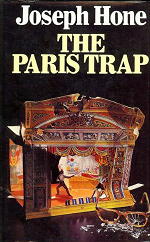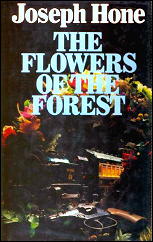September 2010
Monthly Archive
Tue 14 Sep 2010
Posted by Steve under
Reviews[4] Comments
A REVIEW BY CURT J. EVANS:
CAROLYN WELLS – The Umbrella Murder. J. B. Lippincott, US/UK, hardcover, 1931.
Some enterprising satirist should put Raymond Chandler’s Philip Marlowe in a Carolyn Wells’ mystery novel. Given Chandler’s scathing disdain for the rich and socially connected and Wells’ disproportionate admiration for them, the resulting clash of temperaments would be interesting.
In 1931, Dashiell Hammett was making the “hardboiled” style appetizing in the United States, but unflappable Carolyn Wells breezed right on in her usual manner, seemingly oblivious to new trends in crime (though, interestingly, she included Hammett stories in her mystery tale anthologies). The Umbrella Murder sees foul death strike at a fashionable Club Spindrift in coastal New Jersey.
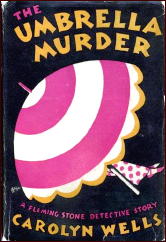
“Neither effort nor expense was spared to make the best and most elaborate beach resort in the country,” reports Wells breathlessly. “The Clubhouse was a gem in itself, and the Casino was another. It was all exclusive, and expensive.”
You might think that someone is murdered with an umbrella at Club Spindrift, but, ha, if so, Wells has fooled you. It seems that wealthy and beautiful heiress Janet Converse has been dispatched with a poisoned syringe while sitting under a beach umbrella, clad in her gaily striped beach pajamas, this season’s “IT” fashion trend (disappointingly, the splendid art deco dust jacket shows the expired Janet clad in polka dot pajamas — given the amount of time Wells devotes to describing the beach pajamas worn by Janet and the girls in her “crowd,” you would have thought cover artist Irving Politzer would have gotten this detail right!).
At one time there were about twenty people, all Janet’s crowd, gathered under the umbrella, so I was wondering whether “The Beach Tent Murder” might have been a more accurate title. Hey, you have to occupy yourself somehow when reading a Carolyn Wells mystery (incidentally, the umbrella on the dust jacket simply could not have afforded shelter to that many people).
But, anyway, Fleming Stone, you may not be surprised to learn, was on the beach; and he soon is pulled into the case, the locals being jaw-droppingly incompetent. It takes Stone, who has horned in on the autopsy, to discover the “minute puncture” on Janet’s left hip. The Great Detective knows what to do next:
“Now, if one of you doctors will cut into the heart, the upper part, and be quick to note any odor–“
“My God!” exclaimed Cutler, “you don’t mean–”
But the coroner made the incision advised by Stone, and immediately both he and Cutler were conscious of a faint smell of bitter almonds:
“Prussic acid!” Cutler cried….
After this interesting scene, the police are obliged to investigate Janet’s crowd, though they have trouble believing the murderer could be one of those “rollicking youngsters,” naturally popular and beloved by all on account of their good looks, stylish clothes, fine breeding and lavish living.
As one man avows: “Those girls are as handsome as any I ever saw, and the boys are thoroughbreds.”
Unfortunately, compounding the disturbing social scandal, a diamond necklace Janet was carrying in a pocket of her beach pajamas (don’t ask) has disappeared, apparently stolen. Worst yet, suspicion starts to center on Janet’s fiancee, Stacpoole Meade, one of the richest of this rich set (his father is Stuyvesant Meade, so that should tell you something).
Surely a son of Stuyvesant Meade couldn’t be involved in murder and theft?! Thankfully, Stacpoole Meade manages to prove his innocence when he gets murdered too.
Meanwhile, back at Janet’s home, a mock castle overlooking the beach named Twin Turrets, Janet’s aunt and heir, spinster Jane Winthrop, is having to deal with an apparent apparition haunting one of the aforementioned turrets, demanding the return of its “treasure.” Fortunately Aunt Jane has a staunch friend in her Irish housekeeper, Molly Mulvaney, who, just to make sure the reader knows she is Irish, says things like this:
“Mercifulation! What a coil! Not only is the poor darling dead, but all the kickooin’ there”ll be straightenen’ of it all out.”
Then Aunt Jane disappears, seemingly kidnapped, perhaps murdered. And a distant cousin shows up to claim the estate (assuming Aunt Jane is dead too). And a strange elderly detective, Humphrey Holt, appears on the scene as well, announcing he wants to help Fleming Stone crack the case. Fleming Stone has his hands full with this one!
WARNING: FURTHER DISCUSSION OF THIS SPLENDID LOOPINESS OF THIS TALE NECESSITATES THE INCLUSION OF MAJOR SPOILERS CONCERNING THE SOLUTION
I’m certain you’ll be amazed as I was to learn that Fleming Stone reveals that Humphrey Holt is really Aunt Jane in disguise! Why did Aunt Jane disappear to do a drag routine? Well, let Aunt Jane explain it herself:
“[T]he only way I could get Janet’s murderer was to pretend to be a detective and so have an opportunity to investigate. Also, I must pose as a man, for a woman detective is no good, and too, I’d be recognized.”
So the intrepid Aunt Jane plucked her bushy eyebrows, “had a new double set of false teeth made” (quick work!), “got her hair shingled and thinned out” and had her brother, with whom she was staying, coach her “in the matter of manly action” (I told you, don’t ask). And she was able to fool everyone in town once she returned, except Fleming Stone, of course.
I’m sure this makes perfect sense to you too.
The most astounding revelation of all, however, is that the murderer turns out to be Janet’s best friend, that beautiful blonde, Eunice Church. We learn to our horror that Eunice is “almost, if not quite, insane” and that she killed Janet and Stacpoole out of jealously over their engagement. After Eunice dispatches herself with another hypodermic syringe (such handy things), Fleming Stone is left free to explain his brilliant deductions to the surviving characters:
“Perhaps you’ve noticed [Eunice’s] mannerism of tucking her thumbs into her curled fingers… That is a sure sign of weakness of character, degeneracy, and even criminal tendency. Then, her head is flat at the back. That is positive proof of hatred, revenge and jealously….[And her ears are] pointed at the top, [with] broad and heavy lobes, and a thin helix…It all points toward a criminal nature… Then her thin lips, her eyes, steel blue at times, though often violet, and her prominent muscular jaw, in spite of her soft chin, all meant homicidal mania that was sure to break out upon provocation.”
Wow! Clearly Eunice should have been drowned at birth. Unfortunately for her criminal schemes, she failed to consult Aunt Jane in disguise techniques, and she fell under the the penetrating gaze of Fleming Stone, an obvious student of physiological criminologist Cesare Lombroso.
How any of this is really fair play detection I don’t see, but apparently Carolyn Wells’ fans were more interested in the details on those smart and fashionable beach pajamas.
One thing I will say in this tale’s favor: Eunice’s hiding place for the stolen diamond necklace (well of course she perpetrated that too — heck, if she hadn’t been stopped cold by Fleming Stone, we probably would be reading about “Eunice and Clyde” today) is quite clever, and reminds me of certain stunts by Dorothy L. Sayers and John Dickson Carr (an adolescent admirer of Miss Wells). I won’t spoil that part!
The rest is purest Gun in Cheek material. The reader is warned.
Editorial Comment: One of the books by Carolyn Wells that Curt has reported back on in recent weeks, and much more favorably, was The Furthest Fury. You can read his review here.
Mon 13 Sep 2010
Posted by Steve under
ReviewsNo Comments
IT IS PURELY MY OPINION
Reviews by L. J. Roberts
BERNARD KNIGHT – The Poisoned Chalice. Pocket, UK, softcover, 1998. Several reprint editions.
Genre: Historical mystery. Leading character: Sir John de Wolf; 2nd in series. Setting: England-Middle Ages/1194.

First Sentence: The chamber was almost in darkness.
Sir John de Wolf’s life has challenges enough with a cold, social-climbing wife and her brother, the power-hungry Sheriff. He now has to solve crimes against women in Medieval Exeter: the betrothed daughter of a wealthy merchant has been raped, and the betrothed daughter of a local noble has died of a botched abortion.
While signs point to the town’s silversmith, John must find the guilty person without the two families killing each other or the Sheriff hanging the wrong person.
It is always a good start when an author includes Author’s Notes, a map and a glossary at the start of an historical mystery. It reveals what license the author has taken, defines the locale and saves me running to the Internet.
More than that, from the very beginning, it brings the book to life. What wonderful characters have been created by Knight. Sir John, his bodyguard Gywn of Polruan and his clerk Thomas de Peyne are a wonderful, not completely harmonious, combination.
Then you have John and his relationship with his wife. I am normally opposed to a protagonist having a mistress, but I’m willing to make an exception here. You empathize with John’s frustrations and cheer his constant struggle to enforce the law.
Knight takes us deep into the 12th century, making it come to life without ever glorifying it. These were hard times and people with hard lives, poor sanitation, the demands of taxation and eternal political wrangling. The legal process was in formation yet laws would change with the kings. I always appreciate an author who can educate and entertain me simultaneously.
The story is well plotted with plenty of intrigue, conflict and drama. The mystery is definitely there and the killer well concealed. The ending felt abrupt and slightly unsatisfying, which is why my rating is lower than it might have been. Even so, the author’s voice and the principal characters make this a captivating series. I look forward to reading the next book.
Rating: Good Plus.
Bibliographic Comments: The Poisoned Chalice is the second of now fourteen books in this “Crowner John” series, the most recent being A Plague of Heretics (2010).
Knight has recently also begun a second series of detective novels, this one taking place in the mid-1950s. The leading character is these, with two having appears so far, is Dr Richard Pryor, a forensic pathologist. (The author himself is a well-known forensics expert.)
For more information on the Bernard Knight and both his fiction and non-fiction, check out his website, located here.
Mon 13 Sep 2010
Posted by Steve under
Reviews[3] Comments
THE ARMCHAIR REVIEWER
Allen J. Hubin
HAROLD ADAMS – The Man Who Met the Train. Mysterious Press, hardcover, 1988. Paperback reprint: 1989.
The latest of Harold Adams’ tales of Carl Wilcox and 1930s South Dakota is The Man Who Met the Train (1988). Wilcox is driving his Model T around the small towns of his area when he comes upon a car accident and rescues a survivor, a four-year-old girl.
He reports the accident to the police in Toquevllle, where the town’s judge hires him to look into the crash. This involves Carl with local muscle-bound youngsters, who take offense at him, with the town’s beauty, which enrages further inhabitants, and with the death a year earlier of Ellsworth Ellison.
Ellison was brilliant and continuously drunk; one day he walked into the side of a train and died. Now, as Wilcox stirs things up, nothing seems accidental any longer.
Evocative and engaging, as usual with this series.
— From The MYSTERY FANcier, Vol. 11, No. 2, Spring 1989.
Bibliographic Note: The Man Who Met the Train is the seventh of sixteen novels featuring itinerant handyman and incidental solver of crimes Carl Wilcox. The final one appeared in 1999. A complete list and cover images of many of them can be found on the Fantastic Fiction website.
Sun 12 Sep 2010
LUKE SHORT – Bold Rider. Dell 1st Edition #7, paperback original; 1st printing, 1953. Reprinted several times. Previously serialized as “Gun-Hammered Gold,†in the Daily News, January 17 through March 5, 1938 (according to copyright renewal records) and the Chicago Tribune (January 18 through March 5).
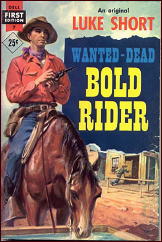
My review not too long ago of First Claim (1960), also by Luke Short (and which you can find here) was not exactly negative, but neither was it positive, either.
What I did say was that I was disappointed, mostly because of a well-worn plot (cowboy comes home from the war to reclaim his land, now held by someone else) and the fact that there were no twists in the tale along the way.
I was not disappointed with Bold Rider, I can tell you that right now. There is plenty of action from start to finish, with definitely more than one thread to the plot, one which you will hard pressed to know which way it will turn next.
Primarily, though, it’s the story of Poco St. Vrain, a chap who’s on the wrong side of the law, according to the law, and awfully handy with a gun, but he’s also a well-liked young fellow whose word, when he gives it, is as good as gold.
And gold is the other part of the story. Two representatives of an insuring company are to act as guardians to a final shipment of the stuff from a mine perched at the top of a mountain, accessible only by a treacherous trail up its side, and all but deadly in the winter. But both men are dead, and their identification papers have fallen into the wrong hands.
Poco poses as one, for nefarious reasons (well, it is gold, after all) and an even more despicable outlaw named Espey Cardowan pretends to be the other. Working independently — neither can call out the other, of course — they must work their way down the mountain again, together and in single file, carrying five hundred pounds of ore between them, and neither trusting the other as far as they can throw them.
To make this small portion of the story short, Poco ends up in a snow-filled ravine with no way out, but then, out of the blue comes… And this is on page 45, with over 145 left to go.
Poco makes his way out of this predicament, of course, you should not be surprised to learn, and he promises the daughter of the mine manager that he will retrieve the gold, a promise not easily kept as ruses, double crosses, shootouts, kidnapping, and a deadly runaway train stand in his way, not to mention the fact that Cardowan turns out to be the most vicious outlaw you may ever want to read about – being responsible for the kidnapping alluded to just now, and the runaway train in which all of the other passengers are dead (at his hand) or have been forced to jump.
There is also the inevitable dance room girl with a heart of gold (there’s that word again), but Steamboat’s not your usual kind of dance room girl. She’s as good with a gun when it becomes necessary as anyone else in this tale, which I am pleased to recommend to you, without a single reservation.
Sun 12 Sep 2010
Reviewed by DAVID L. VINEYARD:
ARNOLD FREDERICKS – The Blue Lights. W. J. Watt & Co., hardcover, 1915. Hardcover reprint: Grosset & Dunlap, no date. Serialized (four parts) in The Cavalier as “The Changing Lights,” January 11 through February 1, 1913.
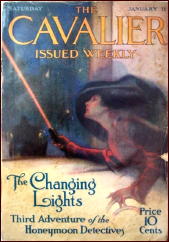
Before there was Nick and Nora Charles, or Pam and Jerry North, or even Lord Peter and Harriet Vane, a pair of happily married American sleuths were pursuing mystery across the international scene fighting crime tooth and nail.
Robert and Grace Duvall were the creation of Frederick Arnold Kummer, a popular mystery writer both under his own name, and as Arnold Fredericks and an early tie to the burgeoning new cinema as both a scenarist and like Arthur B. Reeve, the creator of Craig Kennedy, adapting films to print. He also co wrote musicals with Sigmund Romberg and Victor Herbert — not bad company.
The Duvalls debuted in the pulps in The Cavalier as “The Honeymoon Detectives,” a series Robert Sampson describes in Yesterday’s Faces, The Solvers (Volume 4) as “prose as bland as unsweetened farina.” There Robert Duvall, private investigator, and Grace Elliott, plucky American girl, met and fell in love. [Note: Follow the link above for a long excerpt from Bob Sampson’s book.]
Richard, as the series opens, is a “gifted” private detective assigned to the staff of M. Lefevere, Prefect of the Paris Police.
Despite being such a bright and gifted sleuth, Richard has nothing on Grace, who is front and center for most of their six adventures, finding more ways to get into trouble than Nancy Drew ever imagined. The six books cover a number of changes in the Duvall’s life. As The Blue Lights opens they are retired from crime fighting and living in Maryland on a plantation until Richard’s fame draws him reluctantly back into the world of crime and detection.
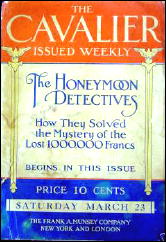
Their adventures are: One Million Francs ( in Cavalier as “The Honeymoon Detectives”), The Ivory Snuff Box (which opens exactly one hour after the first book ends), The Blue Lights (in Cavalier as “The Changing Lights), The Little Fortune, “The Mysterious Goddess,” and Film of Fear (in which Robert aids movie star Ruth Morton).
[Note: The publication dates for these adventures as they appeared in the pulp magazines can be found here. Unaccountably, “The Mysterious Goddess†has never appeared in book form.]
In The Blue Lights an American millionaire’s son has been kidnapped in Paris and his agent rushes to the Duvall’s Maryland estate to enlist Robert in the investigation:
“You must listen to what I have to say, Mr. Duvall, at any rate. Mr. Stapleton would not hear to my returning, after seeing you without having explained to you the nature of the case.”
Duvall leaned back, and began to fondle the long moist nose of the collie which sat beside his chair. “If you insist, Mr. Hodgman, I will listen, of course; but I assure you It will be quite useless.”
“I hope not. The case is most distressing. Mr. Stapleton’s only child has been kidnapped!”
“Kidnapped!” Duvall sat up with a start, every line of his face tense with professional interest. “When? Where?”
“In Paris. The cablegram arrived this morning…”
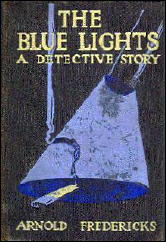
Stapleton is a banker who Duvall has worked for before — a “wealthy banker” as we are told (as opposed to a poor banker one supposes). Duvall reluctantly agrees to take the case. Robert doesn’t want to leave Grace, but she insists: “I think, Robert, that you had better go.”
And go he does, allowing Fredericks to use his favorite device, the divided storyline, following Robert on one hand and Grace on the other, because no sooner has he departed than he receives an urgent message from his old friend and boss M. Lefevere begging him to come to Paris to take over a difficult case.
Grace packs and heads for Paris, unaware that she will arrive there alone because Robert as taken a detour to New Jersey on one of his mysterious missions (like many sleuths of the era Robert is prone to omniscience when he isn’t dense as a teak two by four).
In Paris, Lefevere enlists Grace as his new assistant with typical Gallic resignation:
Immediately on reaching Paris, she drove to the office of the Prefect of Police, and sent in her card to Monsieur Lefevre. She thought it possible that he would expect her, as his agent in Washington would no doubt have communicated with him. Nor was she mistaken.
He rushed into the anteroom as soon as he received her card, and embraced her with true Gallic fervor, kissing her on both cheeks until she blushed. Then he drew her into his private office…
“But — it was for that very case that I desired his assistance. And by this Stapleton, who cables that the whole police force of Paris are a lot of jumping jacks! Sacre! It is insufferable!”
“You wanted my husband for the same case?”
“Assuredly! What else? The child of this pig of a millionaire is stolen — what you call — kidnapped! We have been unable to find the slightest clue. I am in despair… The efficiency of my office is questioned. My honor is at stake. I send for my friend Duvall, to assist me, and — sacre! — I find him already working for this man who has insulted me. It is monstrous!”
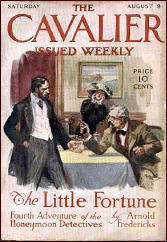
If you didn’t see this coming I have some lovely land in New Mexico I’d like to sell you — nice place called the White Sands Missile Testing Range …
So Grace goes undercover so she will not be recognized as the wife of the brilliant Robert Duvall. Fredericks, true to the nature of the pulps, conveniently fills us in on what Grace is up to:
On the day following that upon which she arrived in Paris, Grace Duvall sallied forth, determined to find out two things — first, the position occupied by Alphonse Valentin in the affair of the kidnapping; secondly, the identity of the man who had stolen the box of cigarettes from Valentin’s room, and gone with them to the house in the Avenue Kleber. The latter incident seemed trivial enough, at first sight; yet she reasoned that no one would risk arrest on the score of burglary, to steal anything of such trifling value, without an excellent reason.
Meanwhile (there are a lot of meanwhile’s in this series) Richard arrives in Paris not knowing Grace is already there and finds his work complicated by his old friend and a police agent he doesn’t realize is a disguised Grace:
“Good Lord, Chief, am I losing my senses? What is this affair, anyway, a joke?”
“Far from it, Monsieur Duvall. The criminals are still at large. The boy is in their hands. We must recover him.”
“But — this money– ”
“I arranged to get it, in order to prevent Monsieur Stapleton from making a fool of himself. I wish to capture these men — not to let them blackmail him out of half a million francs.” “Had you not interfered, Monsieur Lefevre, they would have been in my hands, by now. I would have had them safely the moment they attempted to enter Paris…”
Of course rather than simply explain the truth, everyone is as high handed and thick headed as possible without actually provoking the Dorothy Parker reflex (“This book should not be put aside lightly — it should be thrown with great force.”).
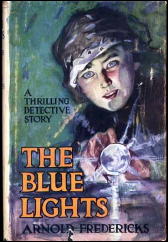
Robert may be “gifted,” but Grace is lucky. At one point she just walks into the kidnapper’s lair and finds the kidnapped child hidden in a plaster casting, then she herself spends a day hiding in a closet from which she luckily overhears all sort of vital information. All I ever heard in a closet was the sound of my clothes being devoured by hungry moths, but then I’m not a plucky sleuth.
Of course on their separate courses the Duvall’s manage to solve the case, rescue the kidnap victim, and capture the villains after a few close calls:
The semidarkness showed a terrifying spectacle. On the floor lay a woman, unconscious, clutching in her arms a child, trapped in a long gray coat. Down the dark hallway leading to the rear of the house dashed the figures of two men. One of them turned, as the attacking party entered, and hurled the lighted candle which he bore full into their faces. The entire scene was instantly plunged into darkness.
Golly!
But Robert brings it to a satisfying conclusion and explains all the convolutions of the case and how everyone but him was wrong, and M. Lefevere resolves that:
“The credit belongs equally to both. And that, my children, is as it should be. This affair, so happily terminated, has taught me one important lesson. It is this: The husband and the wife should never be in opposition to each other. They must work together always, not only in matters of this sort, but in all the affairs of life. I attempted a risky experiment in allowing these two dear friends of mine to attack this case from opposite sides. But for some very excellent strokes of luck, it might have resulted most unhappily for all concerned. Hereafter, should Monsieur Duvall and his wife serve me, it must be together, or not at all.”
You can hardly call these fair play detective stories. Indeed they are full of the sort of thing that the Detection Club and Van Dine’s famous rules were designed to correct, and yet despite prose as “bland as unsweetened farina,” and the high-handed hi-jinks of Robert Duvall, the books are fun and a pleasant read.
And as Robert Sampson points out, Grace Duvall is something refreshing, in that her adventures continue after marriage rather than finding her ensconced in the home like some princess locked away in a tower. For her day she was a breath of fresh air, however musty the plots she was involved in.
I enjoyed this and some of Fredericks other works (available on line at Manybooks and Google Books) on their own merits. Like most popular fiction of the age they require a bit of forgiveness by modern readers, but they also offer some genuine entertainment and polite well behaved thrills.
And historically Grace Duvall is the grande dame of all those bright nosy tec wives to come. She might be a bit staid and prim, but she is a true cousin of Nora Charles, Pam North, Halia Troy, Iris Duluth, Phyllis Shayne, Jean Abbott, Arab Blake, Helene Justus, and the whole attractive brood replete with wicked jaws, long elegant legs (hollow in the case of Nora and Pam), golden curls, and unerring taste for murder.
Though in all fairness after spending an evening with Robert you may well be wishing for one of Nora Charles and Pam North’s stronger martinis… Even as great detectives go, he really is a pain.
Gifted my …
Oh, well, see for yourself.
Sat 11 Sep 2010
Posted by Steve under
Reviews[2] Comments
THE BACKWARD REVIEWER
William F. Deeck
JOSEPH SAMUEL РThe Murdered Clich̩. Quality Press, UK, hardcover, 1947. No US edition.
If this reviewer has any weaknesses, a charge he would vigorously dispute, revealing too much about a book would be foremost. That, of course, presupposes that he understands the book or pretends, if he thinks he can get away with it, that he understands the book.
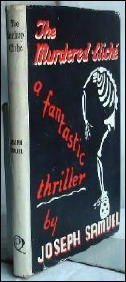
Too much about this one won’t be revealed. In fact, I’m not sure what cliché was murdered.
Samuel’s dedicating the novel “To the Marx Brothers” ‘ should provide a pointer as to what sort of book it will be. The Marx Brothers, however, were lunatics in a sane world, or perhaps vice versa. Here, all is lunatic.
Basil Lord Maltravers, who never did anything with reason, being beyond that sort of pettiness, is found dead by his butler, not in the library or billiard room but in the bathroom, seated upon the commode for the most part, his head having been disattached and placed in the tub.
The butler contends to Lady Maltravers, in her “early plenties,” that it’s murder: “‘Well, I put it to you,’ he began argumentatively, ‘there’s a guy, sat down from his neck down and going to have a bath from his neck up. Now, that’s alright if he’s the kind of man who bathes stood on his head with a chair strapped to his seat. But I think I can say, Ma’am, his Lordship was always free from that kind of bias.'”
Into Elvers Towers, home of the Maltravers, comes Inspector Crimble, stolid, full of common sense, able to move swiftly despite his weight, to scratch his head in perplexity, to be out in all kinds of weather, to hang on with a “‘bulldop” grip, and for all his apparent simplicity not easily led up the garden path. We have seen his like before — and, I believe, since.
But Crimble, despite his many accomplishments, needs help to deal with Lord Maltravers’s wife and the weekend guests–the Hon. Percy Fitznoggy, old Lady Dewlap, young Jimmy Coker, Peggy Chumleigh, and old Amos Boustead, all of them certifiably bonkers, including Crimble. The servants aren’t much better.
Thus, Crimble calls upon Mercure Poitrine, whose waxed mustaches and idiosyncrasies may remind some readers of another Gallic detective. And I didn’t think Poirot could be lampooned! Poitrine solves the case, but–
Well, you wouldn’t believe the ending even if I were so brave as to reveal it. Full of bad puns, some of them amusing, and utterly strange conversations, this novel will appeal only to a few, say those who like me enjoy the early Max Shulman of Barefoot Boy with Cheek or Ross H. Spencer’s caper novels.
— From The MYSTERY FANcier, Vol. 11, No. 2, Spring 1989.
Bibliographic Note: This is the only book by this author to have warranted inclusion in the Revised Crime Fiction IV, by Allen J. Hubin, unless of course Joseph Samuel is not his real name, and then all bets are off.
Sat 11 Sep 2010
Posted by Steve under
Reviews[2] Comments
REVIEWED BY WALTER ALBERT:
EARLENE FOWLER —
â— Fool’s Puzzle. Berkley Prime Crime, hardcover, May 1994; reprint paperback, January 1995.
â— Tumbling Blocks. Berkley Prime Crime, hardcover, May 2007; reprint paperback, May 2008.
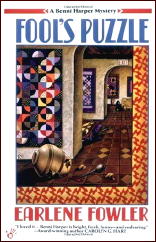
Benni Harper’s husband was killed in a car accident some months before the opening of Fool’s Puzzle, the first in this now long-running series, and she’s moved on, serving as curator of a folk-art museum in the town of San Celina, but with an extended family of relations and friends close at hand. The title, like that of all the other titles in the series, refers to a quilting pattern.
The murder of a potter, who’s been working late at a kiln in the museum, catapults Benni into an unaccustomed role of private investigator, which brings her into conflict with the new sheriff, Gabriel Ortiz, and confirms her character as confrontational and hell bent on putting herself in harm’s way and withholding evidence from the police.
But then, this seems to be the pattern for strong female protagonists (and what female protagonist isn’t strong?), so you can’t expect anything terribly fresh or ground-breaking in the concept of the central character.
What makes the series work is the very adept characterization of a fairly large cast, and the sense of grounding in a diverse, changing community as San Celina, formerly largely a ranch and farming community, develops into a more up-scale town, with the museum, ably directed by Benni, at the center of an influx of touristy galleries, restaurants and shops.
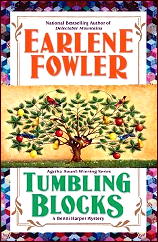
In the thirteenth book in the series, Tumbling Blocks, the museum has landed a prize acquisition, the donation of a painting by a nationally known folk artist, with a presentation gala that’s attracting some major attention from outside the area, and an appearance by the reclusive artist’s great-niece, who is a tireless supporter of his work.
As if Benni doesn’t have enough to do with overseeing the event, she’s coerced by Constance Sinclair, the museum’s major benefactor, into investigating what appears to be the death by natural causes of Constance’s long-time friend “Pinky” Edmondson, but which Constance believes to be a murder.
The investigation by Benni takes back seat for much of the book but when it comes to the forefront makes up for its earlier reticent place in the plot by heating up rapidly and dangerously for Benni.
I don’t know that I’m going to be a tireless pursuer of the other titles, but I enjoyed both of these early and late examples of Fowler’s work.
Bibliographic Note: Number fourteen in the series, State Fair, was published earlier this year. For a complete list and cover images of all fourteen, visit the Fantastic Fiction website page here.
Fri 10 Sep 2010
A REVIEW BY GEORGE KELLEY:
JOSEPH HONE – The Valley of the Fox. St. Martin’s Press, US, hardcover, 1984. Reprint paperback: Collier, US, 1989. First edition: Secker & Warburg, UK, hardcover, 1982.

Joseph Hone has written some fine espionage novels — The Oxford Gambit, The Sixth Directorate and The Private Sector — so The Valley of the Fox comes as a surprise.
Peter Marlow, retired spy featured in the earlier Hone books, marries a beautiful but mysterious widow named Laura whose anthropologist husband was killed in Africa. Laura has a daughter named Clare who doctors have pronounced “autistic” but who holds many surprises.
Marlow’s life is idyllic until a masked man enters his house and kills Laura and attempts to kill Peter. Marlow, finding out he’s being framed fqr his wife’s murder, flees into the surrounding English countryside. There he meets a bizarre woman named Alice who helps him rescue Clare from the nearby hospital and allows Peter and Clare the run of her strange estate.
The plot continues to twist and turn as Marlow investigates his dead wife’s past and the deadly secrets Clare holds. This is not an espionage novel in the conventional sense but Hone manages to pull off an off-beat novel about a retired spy in an incredible plot.
Recommended!
— From The Poisoned Pen, Vol. 6, No. 4, Fall 1986.
Bibliography [Taken from the Revised Crime Fiction IV, by Allen J. Hubin.]
HONE, JOSEPH. 1937– .
The Private Sector (n.) H. Hamilton 1971. Peter Marlow.
The Sixth Directorate (n.) Secker 1975. Peter Marlow.
The Paris Trap (n.) Secker 1977
The Flowers of the Forest (n.) Secker 1980. US title: The Oxford Gambit. Peter Marlow.
The Valley of the Fox (n.) Secker 1982. Peter Marlow.
Fri 10 Sep 2010
Posted by Steve under
Reviews1 Comment
A REVIEW BY MARYELL CLEARY:
MARTHA GRIMES – Jerusalem Inn. Little, Brown & Co., hardcover, 1984. Paperback reprints include: Dell, 1985; Onyx, 2004.
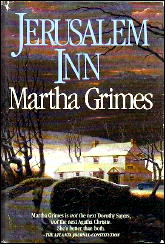
Superintendent Richard Jury meets a woman in a graveyard. He finds her attractive, makes a dinner date, and when he comes to keep it, she is dead — poisoned.
His investigation takes him to the Jerusalem Inn, a country pub where snooker is played in the back room. Meanwhile, fate is busy drawing Jury’s amateur detective friend, Melrose Plant (aka the Earl of Caverness) his Aunt Agatha, and their mutual. friend, Vivian Rivington, to the same vicinity for a Christmas house party.
The guests consist of artists and writers who are taciturn, and dilettantes who definitely aren’t. Nicest of the bunch is young Tommy, ace snooker player, otherwise known as the Marquess of Meares.
Another murder ensues, and a confusion of motives. Jury moves along to a conclusion, but slowly. This is a contemporary version of the old-fashioned British Christmas house party murder mystery, and as such, it really ought to have a final chapter in which everyone is gathered together and everything is explained. Too many loose ends are left untied for my liking.
— Reprinted from The Poisoned Pen, Vol. 6, No. 4, Fall 1986.
Previously reviewed on this blog:
The Black Cat (by Ray O’Leary)
The Case Has Altered (by Steve Lewis)
Fri 10 Sep 2010
A TV Review by MIKE TOONEY:
“Run for Doom.” An episode of The Alfred Hitchcock Hour (Season 1, Episode 31). First air date: 17 May 1963. John Gavin, Diana Dors, Scott Brady, Carl Benton Reid, Tom Skerritt. Teleplay: James Bridges, based on the novel Run for Doom (1962) by Henry Kane. Director: Bernard Girard.
Nickie Carole (Diana Dors) is beautiful and talented. She works as a nightclub singer for Bill Floyd (Scott Brady), whose interest in her is intensely personal; sometimes to get her attention he slaps her around a little, but she seems to enjoy it. Floyd takes her for granted, however, and that will prove to be a fatal error.
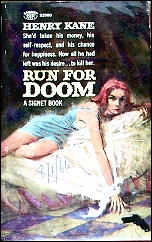
Yes, Nickie is bad news, but that doesn’t stop naive young medico Don Reed (John Gavin) from wanting to marry her. Even after his father (Carl Benton Reid) tells him the findings of a private eye — that Nickie has already beeen married three times to well-to-do men — Don insists on marrying her.
When his father dies unexpectedly, Don comes into a lot of money; so whenever he waves a diamond sparkler under her nose, Nickie’s big eyes get bigger and Don gets even more attractive.
But the girl can’t help it; Nickie tries to seduce another man just to make Don jealous and because she’s bored with married life. What results from this fracas is a lifetime blackmail plan for Don unless he can figure out how to rid himself of this troublesome wench.
And then Floyd re-enters their lives with his own solution to the Nickie Carole dilemma, this time one that involves more than just slapping her around a little…
Diana Dors (a Brit whose accent is always on the verge of manifesting itself) had a reputation for being merely a sex kitten in the Jayne Mansfield tradition, but here she proves that she can act as well as sing provocatively in a strapless evening gown. There isn’t a false note in her performance; she is the perfect femme fatale — and she gets to perform two song numbers, as well.
In addition to Psycho (1960), John Gavin was a spy in OSS 117 (1968) and had two TV series, Destry (1964) and Convoy (1965). Hitchcock reportedly was unhappy with Gavin’s performance in Psycho, but he more than makes up for it here, traversing the emotional gamut from funny to morose and from naive to sinister.
Henry Kane wrote for TV as well as roughly 30 novels and about as many short stories, many of which featured his series character Peter Chambers. As for other media: Martin Kane, Private Eye (6 episodes, 1951-52), Mike Hammer (1 episode, 1958), Kraft Theatre (2 episodes, 1958), the screenplay for Ed McBain’s Cop Hater (1958), Brenner (1 episode, 1959), Johnny Staccato (1 episode, 1959), and The Alfred Hitchcock Hour (2 episodes, 1963).
He even wrote a TV tie-in novel to Peter Gunn (1960), a character some claim may have been “inspired” by Kane’s own Peter Chambers.
You can see “Run for Doom” on Hulu here. For more on Henry Kane and his series character Peter Chambers, read Steve Lewis’s review of Until You Are Dead, earlier here on this blog.
« Previous Page — Next Page »












